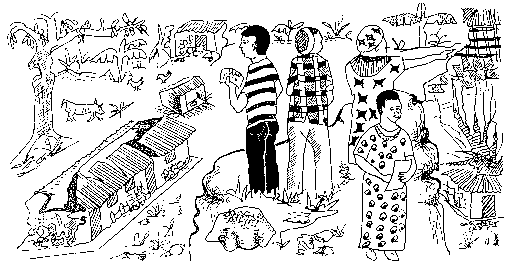Tweet
Translations:
'العربية / al-ʿarabīyah
Bahasa Indonesia
বাংলা / Baṅla
Català
中文 / Zhōngwén
Deutsch
English
Español
Ewe
Filipino/Tagalog
Français
Galego
Ελληνικά / Elliniká
हिन्दी / hindī
Italiano
日本語 / Nihongo
한국어 / Hangugeo
Polszczyzna
Português
Română
Русский
Српски / Srpski
తెలుగు /Telugu
ไทย / Thai
Tiếng Việt
Türkçe
اردو / Urdu
Other formats:
Other Pages:
Modules
Site Map
Key Words
Contact
Utility Documents
Useful Links
Sociology
Assessing Conditions
Introduction to Participatory Appraisal
By Phil Bartle, PhD
Training Handout
An accurate appraisal by the community members is necessary before members can decide upon priorities and agree on a community project to start their action
A community should undertake its activity from an informed base.
The executive committee should make an on-site assessment, analyse it, then present their findings to the community as a whole. This is a "situation analysis."
Although you have already made your own assessment, including a map, as part of your preparation phase, it is important that the executive committee make its own assessment. See Map.
Do not do it for them. They should not delegate it to anyone else.
Set a convenient date for you and the executive committee to walk around the community. Set aside as much time as possible. Walk around all or as much of the community area as you can, looking, talking to people, making notes, drawing sketches. See PAR.
Meet afterwards to compare observations and draw up a combined assessment report. Ask one member of the executive (not you, the mobilizer) to write up the combined findings of the assessment, to be presented to the community as a whole. Their write-up, or report, is called the "situation analysis."
If you can make a few copies of the report (at least maps) to pass around, very good.
In your assessment walk, look for problems and solutions, resources and constraints. Indicate broken water stand pipes and other communal facilities. Show roads that need repair. If you (including the executive) identify an old retired carpenter, determine if he could give some training to some young people; if he is supported by his family would he donate his energy and advice, or need a small honorarium?
Look for other potential resources, human and physical. Note them in the assessment.
After the executive meets to agree upon a combined assessment and after the report is written (copied if possible) they should present their findings to the community as a whole. This requires calling another whole community meeting at a convenient time.
If you, as mobilizer, have a flip chart and news print for their presentation, to loan them, or can borrow some, all the better. You should not present their findings. You facilitate the meeting and let them present their findings to their whole community.
The assessment is a prerequisite to the community plan of action (see CAP).
Ensure that there is complete understanding among the community members what the executive observed, and that there is consensus about the nature and extent of problems and potentials.
A training module is dedicated to participatory appraisal. See PAR.
––»«––
Assessing Conditions
 |